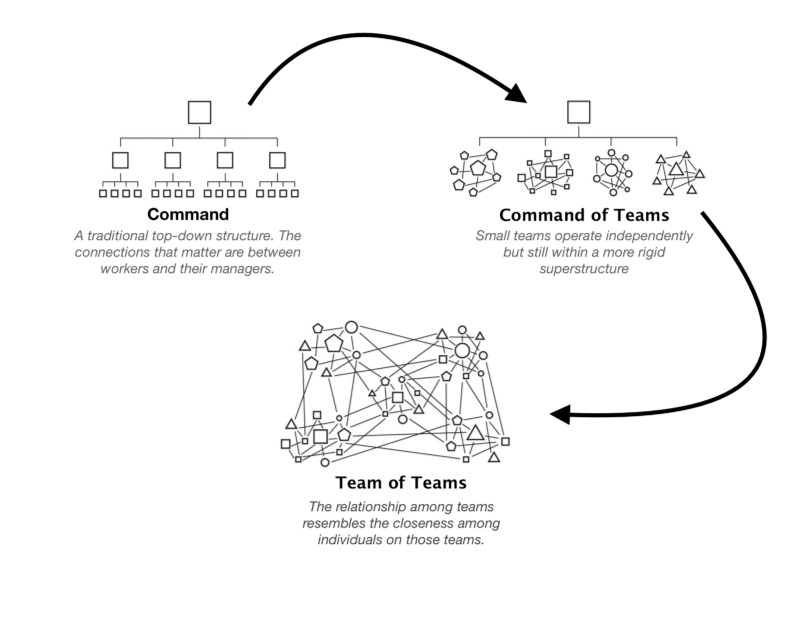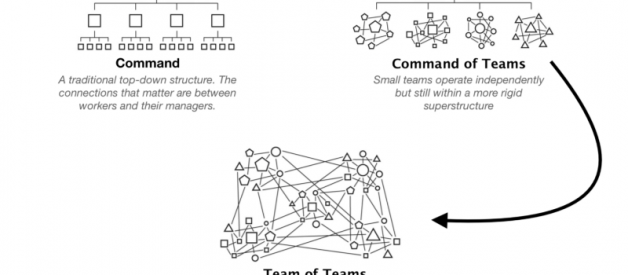
Key takeaways
Reductionist hierarchical management techniques no longer work because organizations are too large for any one person to make all the decisions. The military and Ford motor company use a new management style where your team operates as a network with a shared consciousness and every member is empowered to execute.
Create shared consciousness in your organization by sharing information building genuine relationships and trust. Once you have shared consciousness focus on empowered execution where anyone in the organization can take action without needing approval as long as they provide all contextual information to leaders. Leaders can then take an eyes on hands off approach to management and instead of executing they can focus on fostering an environment conducive to shared consciousness and empowered execution.
Organizations need to be robust and adaptable. Old reductionist management is robust but not adaptable. Adaptable is less efficient but essential in a complex world.
Creating shared consciousness
Teams are effective because they trust each other and they have a shared purpose. This is what we call shared consciousness.
Problem
In the past employees in factories where given tasks which they learned to perform rote but they didn?t have to understand why. Management would do the thinking. Today organizations are too complex for management to do all the thinking.
Understanding the whole
These days you need everyone in your organization to have a holistic understanding of the organization?s work. The European space agency failed because different countries made each part of the rockets. Independently these parts worked but when the rockets were assembled they blew up. NASA avoided this problem by bringing their contractors in-house and mandating that everyone understand the entire project. The military solved this by holding weekly live meetings with the entire task force where everyone could see leaders thought process and contribute if necessary.
Meetings should condense updates into 1/4 of the time, you can the use 3/4 of the time for focused discussion. Team members need to see leadership?s thought process behind problem-solving so the General usually thought out-loud. Here are a few more tips for meetings:
- Cheat sheet with people?s names.
- Ask a question to show you listened.
- No need to give negative feedback in front of people. It can be done in private later.
- Interest and enthusiasm were most powerful behaviors.
- Ask for opinions and advice. Don?t pretend you know everything.
When sending emails leadership should cc everyone who the information is relevant to.
Take all phone calls on speaker phone. Have your EA take notes.
Every meeting should include someone taking notes and distributing action items.
If people can see how their action or inaction contributes to the outcomes they are happier.
Team of teams is a network of networks
GM had over 7,000 employees broken up into many teams. Each team tries to optimize themselves and views other teams with hostility/competition because they didn?t understand what anyone else did. You avoid this by encouraging members to forge relationships with members of other teams. Everyone doesn?t need to know everyone but if everyone knows a couple of people it?s likely there will be at least one connection in your own group to every other team.
Implement tours of duty where team members build relationships with different teams.
Idea flow
Idea flow is the ease with which new thoughts can permeate a group. Pentland likens it to the spread of the flu: a function of susceptibility and frequency of interaction. The key to increasing the contagion is trust and connectivity between otherwise separate elements of an establishment. The two major determinants of idea flow, Pentland has found, are engagement within a small group like a team, a department, or a neighborhood, and exploration, frequent contact with other units.
Empowered execution
Once a shared consciousness gives your team the knowledge to do what is right you must also empower them to act and give them the authority.
If everyone is empowered to act without approval they will be more careful about doing the right thing. People can submit reports to management keeping them updated so they can intervene if needed. Better to ask forgiveness than permission.
Don?t empower employees to execute without first implementing shared consciousness otherwise they could easily do the wrong thing. Think of the financial crises as an example.
Leaders should be gardeners
You are not playing a game of chess where you dictate every move. You create an environment where every piece can simultaneously grow like a gardener.


